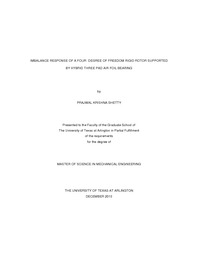
ATTENTION: The works hosted here are being migrated to a new repository that will consolidate resources, improve discoverability, and better show UTA's research impact on the global community. We will update authors as the migration progresses. Please see MavMatrix for more information.
Show simple item record
| dc.contributor.author | Shetty, Prajwal Krishna | en_US |
| dc.date.accessioned | 2011-03-03T21:51:36Z | |
| dc.date.available | 2011-03-03T21:51:36Z | |
| dc.date.issued | 2011-03-03 | |
| dc.date.submitted | January 2010 | en_US |
| dc.identifier.other | DISS-10948 | en_US |
| dc.identifier.uri | http://hdl.handle.net/10106/5430 | |
| dc.description.abstract | Air foil bearings (AFB's) are widely used in small to midsized turbomachinery. They provide safer, cleaner and cheaper bearing operation. They are simple in construction, offer very low drag friction and have very high reliability at high speed operations. A major advantage of air foil bearings compared to conventional rigid surface bearings is their superior dynamic performance in rotor bearing systems. Since there is no contact between the rotor and bearing surface, the air foil bearings have a higher service life compared to rigid surface bearings. Hybrid AFB's operate under both hydrodynamic and hydrostatic condition. The present study is a continuation of the work on hybrid air foil bearings (HAFB) by Kim and Park, where they develop and present an AFB which operates in hydrodynamic condition in the presence of a hydrostatic lift. Their experiments proved that the HAFB's have greater rotor dynamic performance and load capacity compared to their hydrodynamic counterpart. They also showed that HAFB's have better heat dissipation capacity of the parasitic heat generated due to viscous drag of the rotor and due to conduction from various parts of the test rig, thereby enhancing their performance. Later Manish developed a model to determine the bearing stiffness and damping coefficient using linear perturbation method. He also presented detailed study on the dependence of stiffness and damping coefficients on various bearing design parameters like supply pressure, feed parameter, excitation frequency and bearing numberThis article presents the non linear imbalance response of a four degree of freedom (DOF) rigid rotor supported by two, three pad HAFB's. Generally, imbalance response of a rotor has been performed considering two degrees of freedom i.e. cylindrical mode of vibration. This assumption makes it hard to predict the response of rotor bearing system during failure mode of the bearing, since bearing failure occurs predominantly due to conical vibrations. The translational and gyroscopic motion of the rotor has been determined by solving non linear degrees of motion corresponding to the DOF's. Both hydrodynamic and hydrostatic conditions tests were performed using a custom made test rig. Imbalance response simulations were performed and compared with the empirical results. | en_US |
| dc.description.sponsorship | Kim, Daejong | en_US |
| dc.language.iso | en | en_US |
| dc.publisher | Mechanical Engineering | en_US |
| dc.title | Imbalance Response Of A Four Degree Of Freedom Rigid Rotor Supported By Hybrid Three Pad Air Foil Bearing | en_US |
| dc.type | M.S. | en_US |
| dc.contributor.committeeChair | Kim, Daejong | en_US |
| dc.degree.department | Mechanical Engineering | en_US |
| dc.degree.discipline | Mechanical Engineering | en_US |
| dc.degree.grantor | University of Texas at Arlington | en_US |
| dc.degree.level | masters | en_US |
| dc.degree.name | M.S. | en_US |
Files in this item
- Name:
- Shetty_uta_2502M_10948.pdf
- Size:
- 2.427Mb
- Format:
- PDF
This item appears in the following Collection(s)
Show simple item record


